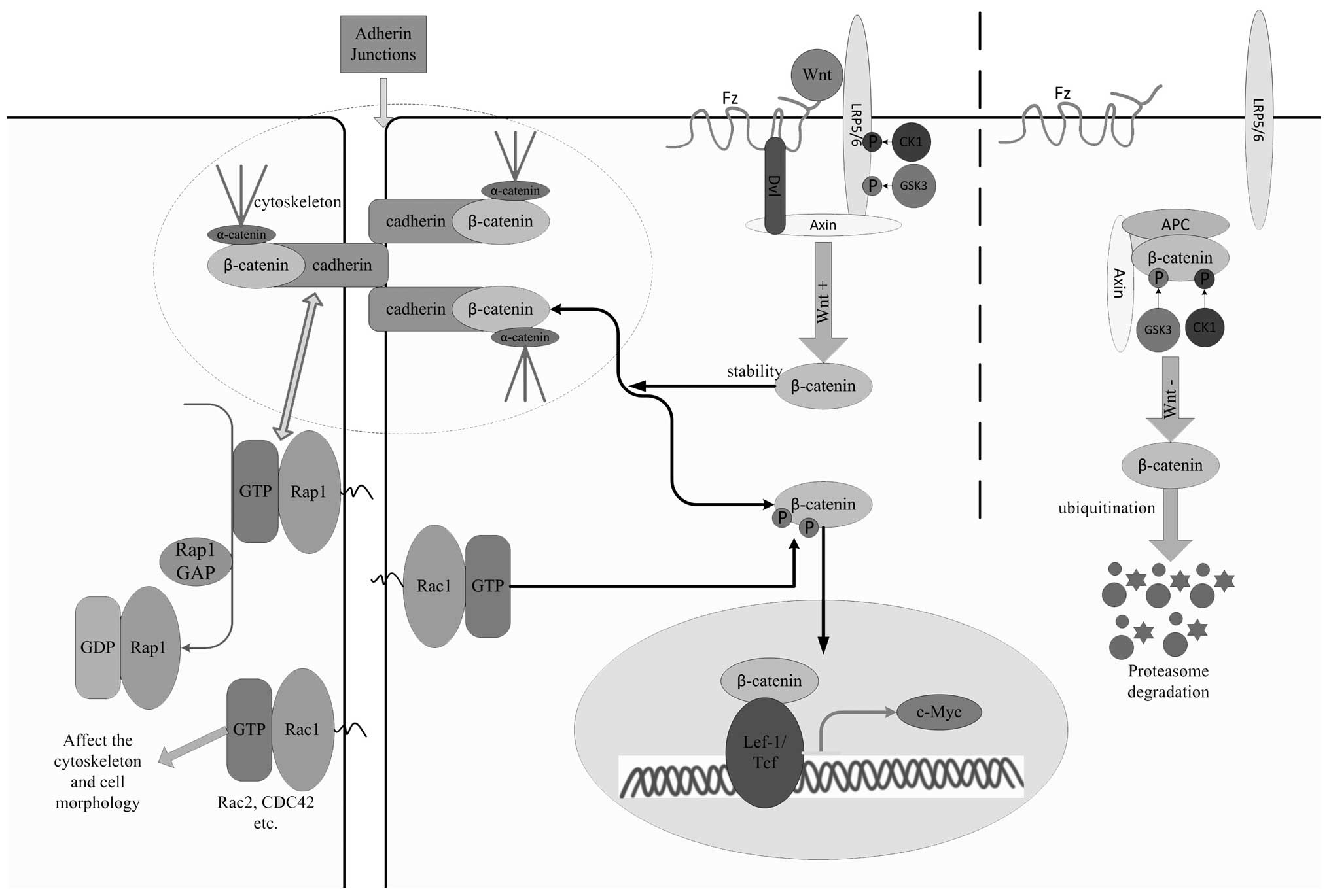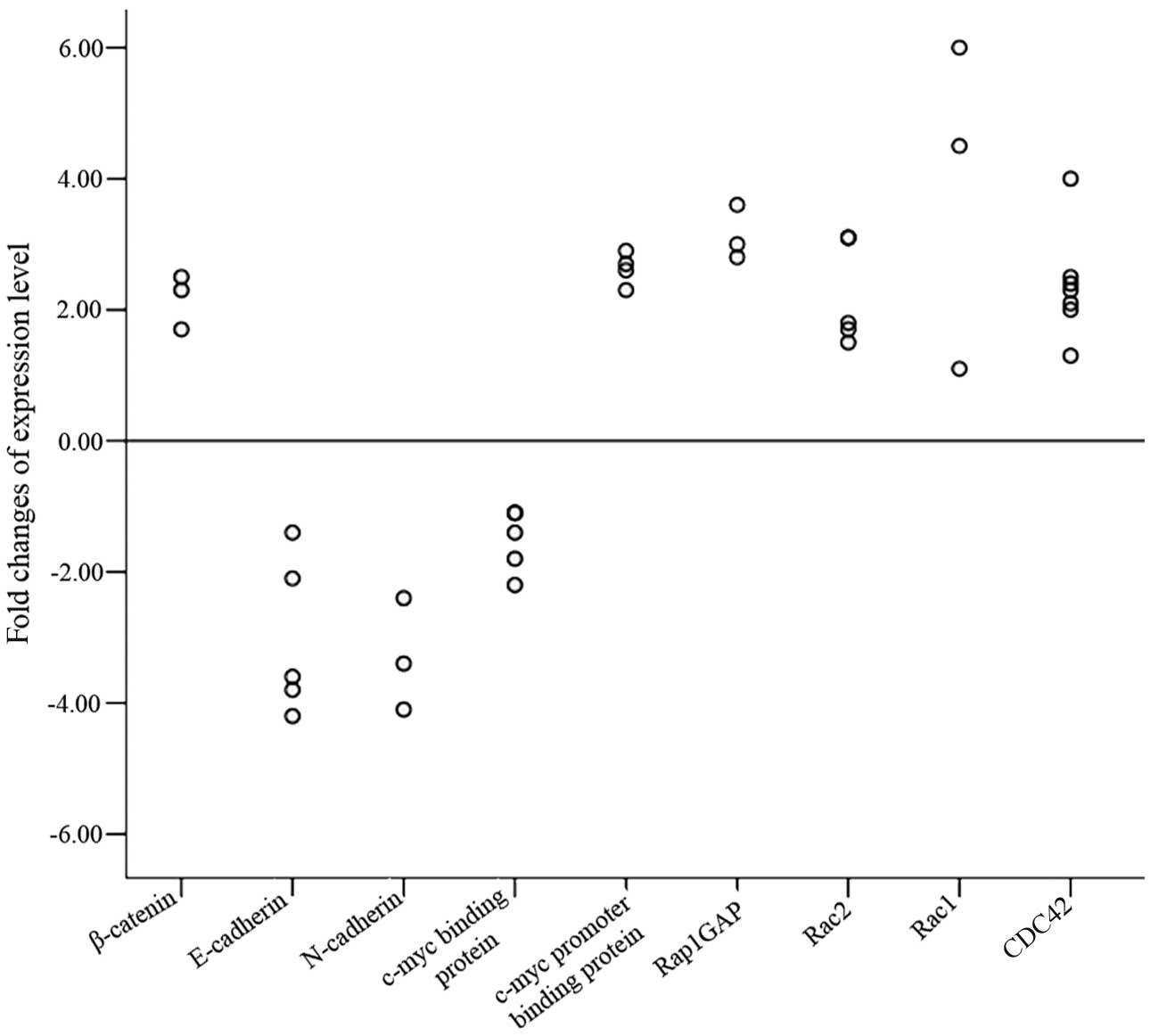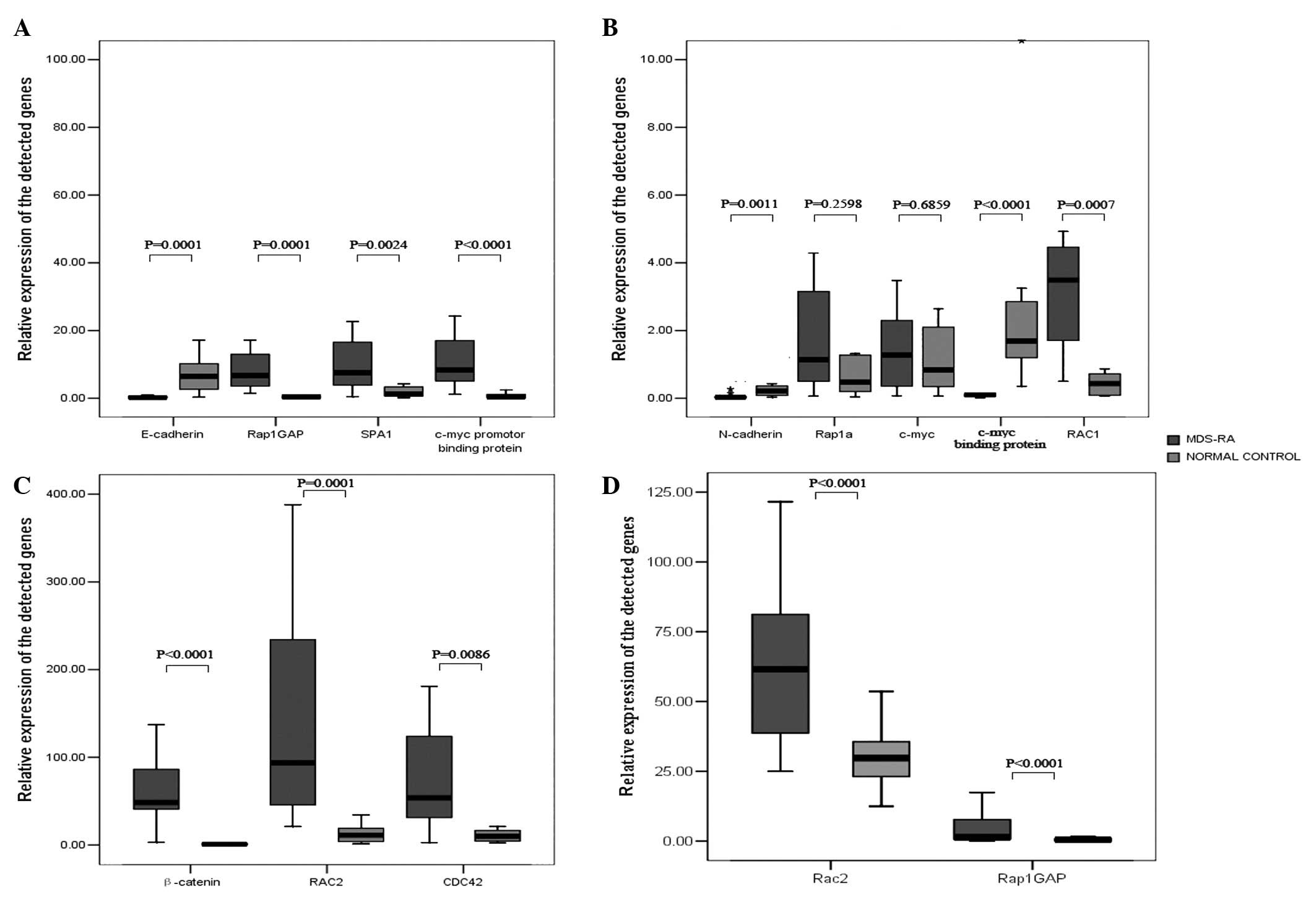|
1
|
Corey SJ, Minden MD, Barber DL, Kantarjian
H, Wang JC and Schimmer AD: Myelodysplastic syndromes: the
complexity of stem-cell diseases. Nat Rev Cancer. 7:118–129. 2007.
View Article : Google Scholar : PubMed/NCBI
|
|
2
|
Nolte F and Hofmann WK: Myelodysplastic
syndromes: molecular pathogenesis and genomic changes. Ann Hematol.
87:777–795. 2008. View Article : Google Scholar : PubMed/NCBI
|
|
3
|
Spradling A, Drummond-Barbosa D and Kai T:
Stem cells find their niche. Nature. 414:98–104. 2001. View Article : Google Scholar : PubMed/NCBI
|
|
4
|
Fuchs E, Tumbar T and Guasch G:
Socializing with the neighbors: Stem cells and their niche. Cell.
116:769–778. 2004. View Article : Google Scholar : PubMed/NCBI
|
|
5
|
Scadden DT: The stem-cell niche as an
entity of action. Nature. 441:1075–1079. 2006. View Article : Google Scholar : PubMed/NCBI
|
|
6
|
Muguruma Y, Yahata T, Miyatake H, Sato T,
Uno T, Itoh J, Kato S, Ito M, Hotta T and Ando K: Reconstitution of
the functional human hematopoietic microenvironment derived from
human mesenchymal stem cells in the murine bone marrow compartment.
Blood. 107:1878–1887. 2006. View Article : Google Scholar
|
|
7
|
Bendall SC, Stewart MH and Bhatia M: Human
embryonic stem cells: lessons from stem cell niches in vivo. Regen
Med. 3:365–376. 2008. View Article : Google Scholar : PubMed/NCBI
|
|
8
|
Calvi LM, Adams GB, Weibrecht KW, Weber
JM, Olson DP, Knight MC, Martin RP, Schipani E, Divieti P,
Bringhurst FR, et al: Osteoblastic cells regulate the
haematopoietic stem cell niche. Nature. 425:841–846. 2003.
View Article : Google Scholar : PubMed/NCBI
|
|
9
|
Zhang J, Niu C, Ye L, Huang H, He X, Tong
WG, Ross J, Haug J, Johnson T, Feng JQ, et al: Identification of
the haematopoietic stem cell niche and control of the niche size.
Nature. 425:836–841. 2003. View Article : Google Scholar : PubMed/NCBI
|
|
10
|
Kiel MJ, Radice GL and Morrison SJ: Lack
of evidence that hematopoietic stem cells depend on
N-cadherin-mediated adhesion to osteoblasts for their maintenance.
Cell Stem Cell. 1:204–217. 2007. View Article : Google Scholar : PubMed/NCBI
|
|
11
|
Lo Celso C, Fleming HE, Wu JW, Zhao CX,
Miake-Lye S, Fujisaki J, Côté D, Rowe DW, Lin CP and Scadden DT:
Live-animal tracking of individual haematopoietic stem/progenitor
cells in their niche. Nature. 457:92–96. 2009.PubMed/NCBI
|
|
12
|
Xie Y, Yin T, Wiegraebe W, He XC, Miller
D, Stark D, Perko K, Alexander R, Schwartz J, Grindley JC, et al:
Detection of functional haematopoietic stem cell niche using
real-time imaging. Nature. 457:97–101. 2009. View Article : Google Scholar : PubMed/NCBI
|
|
13
|
Lee H, Gaughan JP and Tsygankov AY: c-Cbl
facilitates cytoskeletal effects in v-Abl transformed fibroblast
through Rac1- and Rap1-mediated signaling. Int J Biochem Cell Biol.
40:1930–1943. 2008. View Article : Google Scholar : PubMed/NCBI
|
|
14
|
Hosokawa K, Arai F, Yoshihara H, Iwasaki
H, Hembree M, Yin T, Nakamura Y, Gomei Y, Takubo K, Shiama H, et
al: Cadherin based adhesion is a potential target for niche
manipulation to protect hematopoietic stem cells in adult bone
marrow. Cell Stem Cell. 6:194–198. 2010. View Article : Google Scholar : PubMed/NCBI
|
|
15
|
Wilson A, Murphy MJ, Oskarsson T, Kaloulis
K, Bettess MD, Oser GM, Pasche AC, Knabenhans C, Macdonald HR and
Trumpp A: c-Myc controls the balance between hematopoietic stem
cell self-renewal and differentiation. Genes Dev. 18:2747–2763.
2004. View Article : Google Scholar : PubMed/NCBI
|
|
16
|
Haug JS, He XC, Grindley JC, Wunderlich
JP, Gaudenz K, Ross JT, Paulson A, Wagner KP, Xie Y, Zhu R, et al:
N-cadherin expression level distinguishes reserved versus primed
states of hematopoietic stem cells. Cell Stem Cell. 2:367–379.
2008. View Article : Google Scholar : PubMed/NCBI
|
|
17
|
Turel KR and Rao SG: Expression of the
cell adhesion molecule E-cadherin by the human bone marrow stromal
cells and its probable role in CD34(+) stem cell adhesion. Cell
Biol Int. 22:641–648. 1998.PubMed/NCBI
|
|
18
|
Wang L, Menendez P, Cerdan C and Bhatia M:
Hematopoietic development from human embryonic stem cell lines. Exp
Hematol. 33:987–996. 2005. View Article : Google Scholar : PubMed/NCBI
|
|
19
|
Li L, Wang S, Jezierski A, Moalim-Nour L,
Mohib K, Parks RJ, Retta SF and Wang L: A unique interplay between
Rap1 and E-cadherin in the endocytic pathway regulates self-renewal
of human embryonic stem cells. Stem Cells. 28:247–257.
2010.PubMed/NCBI
|
|
20
|
Kirstetter P, Anderson K, Porse BT,
Jacobsen SE and Nerlov C: Activation of the canonical Wnt pathway
leads to loss of hematopoietic stem cell repopulation and
multilineage differentiation block. Nat Immunol. 7:1048–1056. 2006.
View Article : Google Scholar : PubMed/NCBI
|
|
21
|
Maher MT, Flozak AS, Stocker AM, Chenn A
and Gottardi CJ: Activity of the beta-catenin phosphodestruction
complex at cell-cell contacts is enhanced by cadherin-based
adhesion. J Cell Biol. 186:219–228. 2009. View Article : Google Scholar : PubMed/NCBI
|
|
22
|
Nagafuchi A and Takeichi M: Cell binding
function of E-cadherin is regulated by the cytoplasmic domain. EMBO
J. 7:3679–3684. 1988.PubMed/NCBI
|
|
23
|
Meng W and Takeichi M: Adherens junction:
molecular architecture and regulation. Cold Spring Harb Perspect
Biol. 1:a0028992009. View Article : Google Scholar : PubMed/NCBI
|
|
24
|
Stepniak E, Radice GL and Vasioukhin V:
Adhesive and signaling functions of cadherins and catenins in
vertebrate development. Cold Spring Harb Perspect Biol.
1:a0029492009. View Article : Google Scholar : PubMed/NCBI
|
|
25
|
Clevers H: Wnt/beta-catenin signaling in
development and disease. Cell. 127:469–480. 2006. View Article : Google Scholar : PubMed/NCBI
|
|
26
|
MacDonald BT, Tamai K and He X:
Wnt/beta-catenin signaling: components, mechanisms, and diseases.
Dev Cell. 17:9–26. 2009. View Article : Google Scholar : PubMed/NCBI
|
|
27
|
Doucas H, Garcea G, Neal CP, Manson MM and
Berry DP: Changes in the Wnt signaling pathway in gastrointestinal
cancers and their prognostic significance. Eur J Cancer.
41:365–379. 2005. View Article : Google Scholar : PubMed/NCBI
|
|
28
|
Machacek M, Hodgson L, Welch C, Elliott H,
Pertz O, Nalbant P, Abell A, Johnson GL, Hahn KM and Danuser G:
Coordination of Rho GTPase activities during cell protrusion.
Nature. 461:99–103. 2009. View Article : Google Scholar : PubMed/NCBI
|
|
29
|
Mulloy JC, Cancelas JA, Filippi MD, Kalfa
TA, Guo F and Zheng Y: Rho GTPases in hematopoiesis and
hemopathies. Blood. 115:936–947. 2010. View Article : Google Scholar : PubMed/NCBI
|
|
30
|
Hofmann WK, de Vos S, Komor M, Hoelzer D,
Wachsman W and Koeffler HP: Characterization of gene expression of
CD34+ cells from normal and myelodysplastic bone marrow.
Blood. 100:3553–3560. 2002. View Article : Google Scholar : PubMed/NCBI
|
|
31
|
Hosokawa K, Arai F, Yoshihara H, Nakamura
Y, Gomei Y, Iwasaki H, Miyamoto K, Shima H, Ito K and Suda T:
Function of oxidative stress in the regulation of hematopoietic
stem cell-niche interaction. Biochem Biophys Res Commun.
363:578–583. 2007. View Article : Google Scholar : PubMed/NCBI
|
|
32
|
Pyle AD, Lock LF and Donovan PJ:
Neurotrophins mediate human embryonic stem cell survival. Nat
Biotechnol. 24:344–350. 2006. View
Article : Google Scholar : PubMed/NCBI
|
|
33
|
Watanabe K, Ueno M, Kamiya D, Nishiyama A,
Matsumura M, Wataya T, Takahashi JB, Nishikawa S, Nishikawa S,
Muguruma K and Sasai Y: A ROCK inhibitor permits survival of
dissociated human embryonic stem cells. Nat Biotechnol. 25:681–686.
2007. View Article : Google Scholar : PubMed/NCBI
|
|
34
|
Li X, Bryant CE and Deeg HJ: Simultaneous
demonstration of clonal chromosome abnormalities and apoptosis in
individual marrow cells in myelodysplastic syndrome. Int J Hematol.
80:140–145. 2004. View Article : Google Scholar : PubMed/NCBI
|
|
35
|
Wang YY, Cen JN, He J, Shen HJ, Liu DD,
Yao L, Qi XF and Chen ZX: Accelerated cellular senescence in
myelodysplastic syndrome. Exp Hematol. 37:1310–1317. 2009.
View Article : Google Scholar : PubMed/NCBI
|
|
36
|
Balzac F, Avolio M, Degani S, Kaverina I,
Torti M, Silengo L, Small JV and Retta SF: E-cadherin endocytosis
regulates the activity of Rap1: a traffic light GTPase at the
crossroads between cadherin and integrin function. J Cell Sci.
118:4765–4783. 2005. View Article : Google Scholar : PubMed/NCBI
|
|
37
|
Asha H, de Ruiter ND, Wang MG and
Hariharan IK: The Rap1 GTPase functions as a regulator of
morphogenesis in vivo. EMBO J. 18:605–615. 1999. View Article : Google Scholar : PubMed/NCBI
|
|
38
|
Hariharan IK, Carthew RW and Rubin GM: The
Drosophila roughened mutation: activation of a rap homolog
disrupts eye development and interferes with cell determination.
Cell. 67:717–722. 1991.
|
|
39
|
Ohba Y, Ikuta K, Ogura A, Matsuda J,
Mochizuki N, Nagashima K, Kurokawa K, Mayer BJ, Maki K, Miyazaki J
and Matsuda M: Requirement for C3G-dependent Rap1 activation for
cell adhesion and embryogenesis. EMBO J. 20:3333–3341. 2001.
View Article : Google Scholar : PubMed/NCBI
|
|
40
|
Bos JL: Linking Rap to cell adhesion. Curr
Opin Cell Biol. 17:123–128. 2005. View Article : Google Scholar : PubMed/NCBI
|
|
41
|
Knox AL and Brown NH: Rap1 GTPase
regulation of adherens junction positioning and cell adhesion.
Science. 295:1285–1288. 2002. View Article : Google Scholar : PubMed/NCBI
|
|
42
|
Sebzda E, Bracke M, Tugal T, Hogg N and
Cantrell DA: Rap1A positively regulates T cells via integrin
activation rather than inhibiting lymphocyte signaling. Nat
Immunol. 3:251–258. 2002. View
Article : Google Scholar : PubMed/NCBI
|
|
43
|
Price LS, Hajdo-Milasinovic A, Zhao J,
Zwartkruis FJ, Collard JG and Bos JL: Rap1 regulates
E-cadherin-mediated cell-cell adhesion. J Biol Chem.
279:35127–35132. 2004. View Article : Google Scholar : PubMed/NCBI
|
|
44
|
Hogan C, Serpente N, Cogram P, Hosking CR,
Bialucha CU, Feller SM, Braga VM, Birchmeier W and Fujita Y: Rap1
regulates the formation of E-cadherin-based cell-cell contacts. Mol
Cell Biol. 24:6690–6700. 2004. View Article : Google Scholar : PubMed/NCBI
|
|
45
|
Bos JL: All in the family? New insights
and questions regarding interconnectivity of Ras, Rap1 and Ral.
EMBO J. 17:6776–6782. 1998. View Article : Google Scholar : PubMed/NCBI
|
|
46
|
Quilliam LA, Rebhun JF and Castro AF: A
growing family of guanine nucleotide exchange factors is
responsible for activation of Ras-family GTPases. Prog Nucleic Acid
Res Mol Biol. 71:391–444. 2002. View Article : Google Scholar : PubMed/NCBI
|
|
47
|
Bos JL, Rehmann H and Wittinghofer A: GEFs
and GAPs: critical elements in the control of small G proteins.
Cell. 129:865–877. 2007. View Article : Google Scholar : PubMed/NCBI
|
|
48
|
Qi X, Chen Z, Qian J, Cen J and Gu M:
Expression of Rap1GAP in human myeloid disease following microarray
selection. Genet Mol Res. 7:379–387. 2008. View Article : Google Scholar : PubMed/NCBI
|
|
49
|
Ika SA, Qi XF and Chen ZX: Protein RAP1GAP
in human myelodysplastic syndrome detected by flow cytometry and
its clinical relevance. Zhongguo Shi Yan Xue Ye Xue Za Zhi.
17:612–617. 2009.PubMed/NCBI
|
|
50
|
Scheller M, Huelsken J, Rosenbauer F,
Taketo MM, Birchmeier W, Tenen DG and Leutz A: Hematopoietic stem
cell and multilineage defects generated by constitutive
beta-catenin activation. Nat Immunol. 7:1037–1047. 2006. View Article : Google Scholar : PubMed/NCBI
|
|
51
|
Hosokawa K, Arai F, Yoshihara H, Iwasaki
H, Nakamura Y, Gomei Y and Suda T: Knockdown of N-cadherin
suppresses the long-term engraftment of hematopoietic stem cells.
Blood. 116:554–563. 2010. View Article : Google Scholar : PubMed/NCBI
|
|
52
|
Taddei A, Giampietro C, Conti A, Orsenigo
F, Breviario F, Pirazzoli V, Potente M, Daly C, Dimmeler S and
Dejana E: Endothelial adherens junctions control tight junctions by
VE-cadherin-mediated upregulation of claudin-5. Nat Cell Biol.
10:923–934. 2008. View Article : Google Scholar : PubMed/NCBI
|
|
53
|
Heuberger J and Birchmeier W: Interplay of
cadherin-mediated cell adhesion and canonical Wnt signaling. Cold
Spring Harb Perspect Biol. 2:a0029152010. View Article : Google Scholar : PubMed/NCBI
|
|
54
|
Kiel MJ, Yilmaz OH, Iwashita T, Terhorst C
and Morrison SJ: SLAM family receptors distinguish hematopoietic
stem and progenitor cells and reveal endothelial niches for stem
cells. Cell. 121:1109–1121. 2005. View Article : Google Scholar : PubMed/NCBI
|
|
55
|
Frank SR, Schroeder M, Fernandez P,
Taubert S and Amati B: Binding of c-Myc to chromatin mediates
mitogen-induced acetylation of histone H4 and gene activation.
Genes Dev. 15:2069–2082. 2001. View Article : Google Scholar : PubMed/NCBI
|
|
56
|
Staller P, Peukert K, Kiermaier A, Seoane
J, Lukas J, Karsunky H, Möröy T, Bartek J, Massagué J, Hänel F and
Eilers M: Repression of p15INK4b expression by Myc through
association with Miz-1. Nat Cell Biol. 3:392–399. 2001. View Article : Google Scholar : PubMed/NCBI
|
|
57
|
Trumpp A, Refaeli Y, Oskarsson T, Gasser
S, Murphy M, Martin GR and Bishop JM: c-Myc regulates mammalian
body size by controlling cell number but not cell size. Nature.
414:768–773. 2001. View Article : Google Scholar : PubMed/NCBI
|
|
58
|
Rajapaksa R, Ginzton N, Rott LS and
Greenberg PL: Altered oncoprotein expression and apoptosis in
myelodysplastic syndrome marrow cells. Blood. 88:4275–4287.
1996.PubMed/NCBI
|
|
59
|
Wu X, Tu X, Joeng KS, Hilton MJ, Williams
DA and Long F: Rac1 activation controls nuclear localization of
beta-catenin during canonical Wnt signaling. Cell. 133:340–353.
2008. View Article : Google Scholar : PubMed/NCBI
|
|
60
|
Gu Y, Filippi MD, Cancelas JA, Siefring
JE, Williams EP, Jasti AC, Harris CE, Lee AW, Prabhakar R, Atkinson
SJ, et al: Hematopoietic cell regulation by Rac1 and Rac2 guanosine
triphosphatases. Science. 302:445–449. 2003. View Article : Google Scholar : PubMed/NCBI
|
|
61
|
Filippi MD, Szczur K, Harris CE and
Berclaz PY: Rho GTPase Rac1 is critical for neutrophil migration
into the lung. Blood. 109:1257–1264. 2007. View Article : Google Scholar : PubMed/NCBI
|
|
62
|
Roberts AW, Kim C, Zhen L, Lowe JB, Kapur
R, Petryniak B, Spaetti A, Pollock JD, Borneo JB, Bradford GB, et
al: Deficiency of the hematopoietic cell-specific Rho family GTPase
Rac2 is characterized by abnormalities in neutrophil function and
host defense. Immunity. 10:183–196. 1999. View Article : Google Scholar : PubMed/NCBI
|
|
63
|
Sun CX, Downey GP, Zhu F, Koh AL, Thang H
and Glogauer M: Rac1 is the small GTPase responsible for regulating
the neutrophil chemotaxis compass. Blood. 104:3758–3765. 2004.
View Article : Google Scholar : PubMed/NCBI
|
|
64
|
Szczur K, Xu H, Atkinson S, Zheng Y and
Filippi MD: Rho GTPase CDC42 regulates directionality and random
movement via distinct MAPK pathways in neutrophils. Blood.
108:4205–4213. 2006. View Article : Google Scholar : PubMed/NCBI
|
|
65
|
Szczur K, Zheng Y and Filippi MD: The
small Rho GTPase Cdc42 regulates neutrophil polarity via CD11b
integrin signaling. Blood. 114:4527–4537. 2009. View Article : Google Scholar : PubMed/NCBI
|
|
66
|
Pestonjamasp KN, Forster C, Sun C,
Gardiner EM, Bohl B, Weiner O, Bokoch GM and Glogauer M: Rac1 links
leading edge and uropod events through Rho and myosin activation
during chemotaxis. Blood. 108:2814–2820. 2006. View Article : Google Scholar : PubMed/NCBI
|
|
67
|
Ferguson GJ, Milne L, Kulkarni S, Sasaki
T, Walker S, Andrews S, Crabbe T, Finan P, Jones G, Jackson S, et
al: PI(3)Kgamma has an important context-dependent role in
neutrophil chemokinesis. Nat Cell Biol. 9:86–91. 2007. View Article : Google Scholar : PubMed/NCBI
|
|
68
|
Yang FC, Atkinson SJ, Gu Y, Borneo JB,
Roberts AW, Zheng Y, Pennington J and Williams DA: Rac and Cdc42
GTPases control hematopoietic stem cell shape, adhesion, migration,
and mobilization. Proc Natl Acad Sci USA. 98:5614–5618. 2001.
View Article : Google Scholar : PubMed/NCBI
|
|
69
|
Cancelas JA, Lee AW, Prabhakar R, Stringer
KF, Zheng Y and Williams DA: Rac GTPases differentially integrate
signals regulating hematopoietic stem cell localization. Nat Med.
11:886–891. 2005. View
Article : Google Scholar : PubMed/NCBI
|
|
70
|
Wang L, Yang L, Filippi M, Williams D and
Zheng Y: Genetic deletion of Cdc42GAP reveals a role of Cdc42 in
erythropoiesis and hematopoietic stem/progenitor cell survival,
adhesion, and engraftment. Blood. 107:98–105. 2006. View Article : Google Scholar : PubMed/NCBI
|
|
71
|
Yang L, Wang L, Geiger H, Cancelas JA, Mo
J and Zheng Y: Rho GTPase Cdc42 coordinates hematopoietic stem cell
quiescence and niche interaction in the bone marrow. Proc Natl Acad
Sci USA. 104:5091–5096. 2007. View Article : Google Scholar : PubMed/NCBI
|
|
72
|
Raaijmakers MH, Mukherjee S, Guo S, Zhang
S, Kobayashi T, Schoonmaker JA, Ebert BL, Al-Shahrour F, Hasserjian
RP, Scadden EO, et al: Bone progenitor dysfunction induces
myelodysplasia and secondary leukemia. Nature. 464:852–857. 2010.
View Article : Google Scholar : PubMed/NCBI
|
|
73
|
Petronis A: Epigenetics as a unifying
principle in the aetiology of complex traits and diseases. Nature.
465:721–727. 2010. View Article : Google Scholar : PubMed/NCBI
|

















